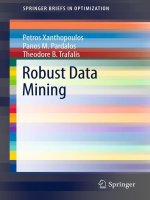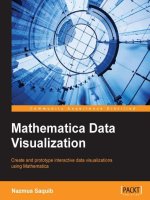IT training fast data enterprise data architecture khotailieu
Bạn đang xem bản rút gọn của tài liệu. Xem và tải ngay bản đầy đủ của tài liệu tại đây (4.44 MB, 47 trang )
Make Data Work
strataconf.com
Presented by O’Reilly and Cloudera,
Strata + Hadoop World is where
cutting-edge data science and new
business fundamentals intersect—
and merge.
n
n
n
Learn business applications of
data technologies
Develop new skills through
trainings and in-depth tutorials
Connect with an international
community of thousands who
work with data
Job # 15420
Fast Data and the New
Enterprise Data
Architecture
Scott Jarr
Fast Data and the New Enterprise Data Architecture
by Scott Jarr
Copyright © 2015 VoltDB, Inc. All rights reserved.
Printed in the United States of America.
Published by O’Reilly Media, Inc., 1005 Gravenstein Highway North, Sebastopol, CA
95472.
O’Reilly books may be purchased for educational, business, or sales promotional use.
Online editions are also available for most titles (). For
more information, contact our corporate/institutional sales department: 800-998-9938
or
Editor: Jenn Webb
October 2014:
Illustrator: Rebecca Demarest
First Edition
Revision History for the First Edition:
2014-09-24:
First release
See for release details.
The O’Reilly logo is a registered trademark of O’Reilly Media, Inc. Fast Data and the
New Enterprise Data Architecture and related trade dress are trademarks of O’Reilly
Media, Inc.
Many of the designations used by manufacturers and sellers to distinguish their prod‐
ucts are claimed as trademarks. Where those designations appear in this book, and
O’Reilly Media, Inc. was aware of a trademark claim, the designations have been printed
in caps or initial caps.
While the publisher and the author have used good faith efforts to ensure that the
information and instructions contained in this work are accurate, the publisher and
the author disclaim all responsibility for errors or omissions, including without limi‐
tation responsibility for damages resulting from the use of or reliance on this work.
Use of the information and instructions contained in this work is at your own risk. If
any code samples or other technology this work contains or describes is subject to open
source licenses or the intellectual property rights of others, it is your responsibility to
ensure that your use thereof complies with such licenses and/or rights.
ISBN: 978-1-491-91393-2
[LSI]
Table of Contents
Preface. . . . . . . . . . . . . . . . . . . . . . . . . . . . . . . . . . . . . . . . . . . . . . . . . . . . . . . . v
1. What’s Shaping the Environment. . . . . . . . . . . . . . . . . . . . . . . . . . . . . . 1
Data Is Everywhere
Data Is Fast Before It’s Big
1
2
2. The Enterprise Data Architecture. . . . . . . . . . . . . . . . . . . . . . . . . . . . . . . 5
Introduction
Data and the Database Universe
Architecture Matters
5
6
8
3. Components of the Enterprise Data Architecture. . . . . . . . . . . . . . . . . 9
Big Data, the Enterprise Data Architecture, and the Data
Lake
Integrating Traditional Enterprise Applications into the
Enterprise Data Architecture
Fast Data in the Enterprise Data Architecture
An End-to-End Illustration of the Enterprise Data
Architecture in Action
10
11
12
12
4. Why Is There Fast Data?. . . . . . . . . . . . . . . . . . . . . . . . . . . . . . . . . . . . . 15
Fast Data Bridges Operational Work and the Data Pipeline
Fast Data Frontier—The Inevitability of Fast Data
Make Faster Decisions; Don’t Settle Only for Faster
Analytics
Applications and Analytics Merge
Progression to Realtime Analytics Necessitates Automated
Decisions
15
15
16
16
17
iii
5. Requirements of Fast Data Systems in the Enterprise Data
Architecture. . . . . . . . . . . . . . . . . . . . . . . . . . . . . . . . . . . . . . . . . . . . . . . 19
Building an Architecture for Fast Data
1. Ingest/interact with the data feed
2. Make decisions on each event in the feed
3. Provide visibility into fast-moving data with
realtime analytics
20
20
20
21
6. Fast Data Applications (and Most of Them Are). . . . . . . . . . . . . . . . . . 25
Industries That Have Historically Dealt with Fast Data
Challenges in a Siloed Way
Industries Being Transformed by the Changes Data
Represents
Future Applications Where Data Is the Major Value
26
26
27
7. How Fast and Big Applications Will Enter the Enterprise. . . . . . . . . . 29
Existing Applications
New Applications, Existing Data Sources
New Applications, New Data Sources
New Data-Driven Enterprise Integration
29
30
31
31
8. Getting There: Making the Right Fast Data Technology Choices. . . . 33
Architectural Approaches to Delivering Fast Data
Fast OLAP Systems
Stream Processing Systems
Operational Database Systems
33
33
34
34
9. Conclusion. . . . . . . . . . . . . . . . . . . . . . . . . . . . . . . . . . . . . . . . . . . . . . . . 37
iv
| Table of Contents
Preface
A structural shift in data management is underway. Unlike previous
eras of technological change—mainframe to server, server to PC, PC
to mobile and tablet—this shift is not driven solely by growth in pro‐
cessing power (the oft-cited Moore’s Law). Today, processing power is
cheap at the endpoints. The combination of cheap, ubiquitous CPUs
attached to fast mobile networks is creating a network effect of devices,
distorting Moore’s Law with the force multiplier of near-global wire‐
less network coverage. Thus, today’s shift is spurred not only by in‐
creases in processing power but also by the growth of data—of new
data, which is doubling every two years—and by the rate of growth in
the perceived value of data.
These macro computing trends are causing a swift adoption of new
data management technologies. Open source software solutions and
innovations such as in-memory databases are enabling organizations
to reap the value of realtime interactions and observations. No longer
is it necessary to wait for insight until the data has been analyzed deeply
in a big data store. This is changing the way in which enterprises man‐
age data, both data in motion--"fast data” streaming in from millions
of endpoints—and data at rest, or “big data” stored in Hadoop and
data warehouses.
v
Businesses in the vanguard of this change recognize that they operate
in a “data economy.” These leaders make an important distinction be‐
tween the two major ways in which they interact with data. This shift
in thinking has led to the creation of a new enterprise data architecture.
This book will discuss what the new enterprise data architecture looks
like as well as the benefits it will deliver to organizations. It will also
outline the major technology components necessary to build a unified
enterprise data architecture, one in which both fast data and big data
work together.
vi
| Preface
CHAPTER 1
What’s Shaping the Environment
Data Is Everywhere
The digitization of the world has fueled unprecedented growth in data,
much of it driven by the global explosion of mobile data sources and
the Internet of Things (IoT). Each day, more devices—from smart‐
phones to cars to electric grids—are being connected and intercon‐
nected. It is safe to predict that within the next 10–15 years, anything
powered by electricity will be connected to the Internet.
According to the 2014 EMC/IDC Digital Universe report, data is dou‐
bling in size every two years. In 2013, more than 4.4 zetabyes of data
had been created; by 2020, the report predicts that number will explode
by a factor of 10 to 44 zetabytes—44 trillion gigabytes. The report also
notes that people—consumers and workers—created some two-thirds
of 2013’s data; in the next decade, more data will be created by things
—sensors and embedded devices. In the report, IDC estimates that the
IoT had nearly 200 billion connected devices in 2013 and predicts that
number will grow 50% by 2020 as more devices are connected to the
Internet—smartphones, cars, sensor networks, sports tracking mon‐
itors, and more.
Data from these connected devices is fueling a data economy, creating
huge implications for future business opportunity. Additionally, the
rate of growth of new data is creating a structural change in the ways
enterprises, which are responsible for more than 80% of the world’s
data, manage and interact with that data.
As the data economy evolves, an important distinction between the
major ways in which businesses interact with data is emerging. Com‐
1
panies have begun to interact with data that is big—data that has vol‐
ume and variety. Additionally, as companies embark on ever-more
extensive big data initiatives, they have also realized the importance
of interacting with data that is fast. The ability to process data imme‐
diately—a requirement driven by IoT macro-trends—creates new op‐
portunity to realize value via disruptive business models.
To illustrate this point, consider the devices generating all this data.
Some are relatively dumb sensors that generate a one-way flow of in‐
formation—for example, network sensors that push data to a process‐
ing hub but that cannot communicate with one another. More im‐
portant are two-way sensors embedded in “smart” devices—for ex‐
ample, automotive in-vehicle infotainment and navigation systems
and smart meters used in smart power grids. These two-way sensors
not only collect data but also enable organizations to analyze and make
decisions on that data in real time, pushing results (more data) back
to the device. These smart sensors create huge streams of fast, smart
data; they can act autonomously on “your” inputs as well as act col‐
lectively on the group’s inputs.
The EMC/IDC report states that “embedded systems—the sensors and
systems that monitor the physical universe—already account for 2%
of the digital universe. By 2020 that will rise to 10%.” Clearly, two-way
sensors that generate fast and big data require different modes of in‐
teraction if the data is to have any business value. These different
modes of interaction require the new capabilities of the enterprise data
architecture.
Data Is Fast Before It’s Big
It is important to note that the discussion in this book is contained to
what are described as “data-driven applications.” These applications
are pervasive in many organizations and are characterized by utiliza‐
tion of data at scales previously unobtainable. This scale can refer to
the complexity of the analysis, the sheer amount of data being man‐
aged, or the velocity at which data must be acted upon.
Simply stated, data is fast before it is big. With the increase in fast data
comes the opportunity to act on fast and big data in a way that creates
the most compelling vision for data-driven applications.
Fast data is a new opportunity made possible by emerging technologies
and, in many cases, by new approaches to established technologies,
e.g., in-memory databases. In the new paradigm—one in which data
2
|
Chapter 1: What’s Shaping the Environment
in motion has equal or greater value than “historical” data (data at rest)
—new opportunities to extract value require that enterprises adopt
new approaches to data management. Many traditional database ar‐
chitectures and systems are incapable of dealing with fast data’s chal‐
lenges.
As a result, the data management industry has been enveloped in con‐
fusion, much of it driven by hype surrounding the major forces of big
data, cloud, and mobility. Fortunately, many of the available technol‐
ogies are falling into categories based on problems they address, bring‐
ing the picture into better focus. This is good news for application
developers, as advances in cloud computing and in-memory database
architectures mean familiar tools can be used to tackle fast data.
Data Is Everywhere
|
3
CHAPTER 2
The Enterprise Data Architecture
Introduction
The enterprise data architecture is a break from the traditional siloed
data application, where data is disconnected from the analytics and
other applications and data. The enterprise data architecture supports
fast data created in a multitude of new end points, operationalizes the
use of that data in applications, and moves data to a “data lake” where
services are available for the deep, long-term storage and analytics
needs of the enterprise. The enterprise data architecture can be rep‐
resented as a data pipeline that unifies applications, analytics, and ap‐
plication interaction across multiple functions, products, and disci‐
plines (see Figure 2-1).
Figure 2-1. Fast data represents the velocity aspect of big data.
5
Data and the Database Universe
Key to understanding the need for an enterprise data architecture is
an examination of the “database universe” concept, which illustrates
the tight link between the age of data and its value.
Most technologists understand that data exists on a time continuum;
it is not stationary. In almost every business, data moves from function
to function to inform business decisions at all levels of the organiza‐
tion. While data silos still exist, many organizations are moving away
from the practice of dumping data in a database—e.g., Oracle, DB2,
MSSQL, etc.—and holding it statically for long periods of time before
taking action.
Figure 2-2. Data has the greatest value as it enters the pipeline, where
realtime interactions can power business decisions, e.g., customer in‐
teraction, security and fraud prevention, and optimization of resource
utilization.
The actions companies take with data are increasingly correlated to
the data’s age. Figure 2-2 represents time as the horizontal axis. To the
6
|
Chapter 2: The Enterprise Data Architecture
far left is the point at which data is created. Immediately after data is
created, it is highly interactive and for each event, of greatest value.
This is where the opportunity exists to perform high-velocity opera‐
tions on “new” or “incoming” data—for example, to place a trade,
make a recommendation, serve an ad, or inspect a record. This is the
beginning of a data management pipeline.
Shortly after data enters the pipeline, it can be examined relative to
other data that has also arrived recently, e.g., by examining network
traffic trends, composite risk by trading desk, or the state of an online
game leader board.
Queries on fresh data in motion are commonly referred to as “realtime
analytics.”
As data begins to age, the nature of its value begins to change; it be‐
comes useful in a historical context and relative to other sources of
data. For example, knowing a buyer’s preference after a purchase is
clearly less valuable than it would be during the purchase.
Organizations have found countless ways to gain valuable insights,
such as trends, patterns, and anomalies, from data over long timelines
and from multiple sources. Business intelligence and reporting are
examples of what can be done to extract value from historical data.
Additionally, big data applications are increasingly used to explore
historical data for deeper insights—not just observing trends, but dis‐
covering them. This can be thought of as “exploratory analytics.”
With the adoption of fast and big data technologies, a trend is emerging
in the way data management applications are being architected, de‐
signed, and developed. A central tenet underlies modern data archi‐
tecture design:
The value in data is not purely from historical insights.
There is a natural push for analytics to be visible closer and closer to
real time. As this occurs, it becomes obvious that taking action on this
information, in real time, the instant it is created, is the ultimate goal
of an enterprise data architecture. As a result, the historically separate
functions of the “application” and the “analytics” begin to merge.
Enterprises are examining how they build new applications and new
analytics capabilities. This natural progression quickly takes people to
the point at which they realize they need a unifying architecture to
serve as the basis for how data-heavy applications will be built across
the company, encompassing application interaction all the way
Data and the Database Universe
|
7
through to exploratory analytics. What has changed is that application
interactions are now part of the pipeline. The result of this work is the
modern enterprise data architecture.
Architecture Matters
Interacting with fast data is a fundamentally different process than
interacting with big data that is at rest, requiring systems that are ar‐
chitected differently. With the correct assembly of components that
reflect the reality that application and analytics are merging, an en‐
terprise data architecture can be built that achieves the needs of both
data in motion (fast) and data at rest (big).
Building high-performance applications that can take advantage of
fast data is a new challenge. Combining these capabilities with big data
analytics into an enterprise data architecture is increasingly becoming
table stakes. But not everyone is prepared to play.
8
|
Chapter 2: The Enterprise Data Architecture
CHAPTER 3
Components of the Enterprise
Data Architecture
Figure 3-1 illustrates the main components of an enterprise data ar‐
chitecture. The architectural requirements of the separation of fast and
big are evident, with the capabilities and requirements of each pre‐
sented.
Figure 3-1. Note the tight coupling of fast and big, which must be sep‐
arate systems at scale.
9
The first thing to notice is the tight coupling of fast and big, although
they are separate systems; they have to be, at least at scale. The database
system designed to work with millions of event decisions per second
is wholly different from the system designed to hold petabytes of data
and generate extensive historical reports.
Big Data, the Enterprise Data Architecture,
and the Data Lake
The big data portion of the architecture is centered around a data lake,
the storage location in which the enterprise dumps all of its data. This
component is a critical attribute for a data pipeline that must capture
all information. The data lake is not necessarily unique because of its
design or functionality; rather, its importance comes from the fact that
it can present an enormously cost-effective system to store everything.
Essentially, it is a distributed file system on cheap commodity hard‐
ware.
Today, the Hadoop Distributed File System (HDFS) looks like a suit‐
able alternative for this data lake, but it is by no means the only answer.
There might be multiple winning technologies that provide solutions
to the need.
The big data platform’s core requirements are to store historical data
that will be sent or shared with other data management products, and
also to support frameworks for executing jobs directly against the data
in the data lake.
Refer back to Figure 3-1 for the components necessary for a new en‐
terprise data architecture. In a clockwise direction around the outside
of the data lake are the complementary pieces of technology that en‐
able businesses to gain insight and value from data stored in the data
lake:
Business intelligence (BI) – reporting
Data warehouses do an excellent job of reporting and will con‐
tinue to offer this capability. Some data will be exported to those
systems and temporarily stored there, while other data will be ac‐
cessed directly from the data lake in a hybrid fashion. These data
warehouse systems were specifically designed to run complex re‐
port analytics, and do this well.
10
|
Chapter 3: Components of the Enterprise Data Architecture
SQL on Hadoop
Much innovation is happening in this space. The goal of many of
these products is to displace the data warehouse. Advances have
been made with the likes of Hawq and Impala. Nevertheless, these
systems have a long way to go to get near the speed and efficiency
of data warehouses, especially those with columnar designs. SQLon-Hadoop systems exist for a couple of important reasons:
a. SQL is still the best way to query data
b. Processing can occur without moving big chunks of data
around
Exploratory analytics
This is the realm of the data scientist. These tools offer the ability
to “find” things in data: patterns, obscure relationships, statistical
rules, etc. Mahout and R are popular tools in this category.
Job scheduling
This is a loosely named group of job scheduling and management
tasks that often occur in Hadoop. Many Hadoop use cases today
involve pre-processing or cleaning data prior to the use of the
analytics tools described above. These tools and interfaces allow
that to happen.
The big data side of the enterprise data architecture has, to date, gained
the lion’s share of attention. Few would debate the fact that Hadoop
has sparked the imagination of what’s possible when data is fully uti‐
lized. However, the reality of how this data will be leveraged is still
largely unknown.
Integrating Traditional Enterprise
Applications into the Enterprise Data
Architecture
The new enterprise data architecture can coexist with traditional ap‐
plications until the time at which those applications require the capa‐
bilities of the enterprise data architecture. They will then be merged
into the data pipeline.
The predominant way in which this integration occurs today, and will
continue for the foreseeable future, is through an extract, transform,
and load (ETL) process that extracts, transforms as required, and loads
Integrating Traditional Enterprise Applications into the Enterprise Data Architecture
|
11
legacy data into the data lake where everything is stored. These appli‐
cations will migrate to full-fledged fast + big data applications in time
(this is discussed in detail in Chapter 7).
Fast Data in the Enterprise Data Architecture
The enterprise data architecture is split into two main capabilities,
loosely coupled in bidirectional communications— fast data and big
data. The fast data segment of the enterprise data architecture includes
a fast in-memory database component. This segment of the enterprise
data architecture has a number of critical requirements, which include
the ability to ingest and interact with the data feed(s), make decisions
on each event in the feed(s), and apply realtime analytics to provide
visibility into fast streams of incoming data.
The following use case and characteristic observations will set a com‐
mon understanding for defining the requirements and design of the
enterprise data architecture. The first is the fast data capability.
An End-to-End Illustration of the Enterprise
Data Architecture in Action
The IoT provides great examples of the benefits that can be achieved
with fast data. For example, there are significant asset management
challenges when managing physical assets in precious metal mines.
Complex software systems are being developed to manage sensors on
several hundred thousand “things” that are in the mine at any given
time.
To realize this value, the first challenge is to ingest streams of data
coming from the sheer quantity of sensors. Ingesting on average 10
readings a second from 100,000 devices, for instance, represents a large
ingestion stream of one million events per second.
But ingesting this data is the smallest and simplest of the tasks required
in managing these types of streams. As sensor readings are ingested
into the system, a number of decisions must be made against each
event, as the event arrives. Have all devices reported readings that they
are expected to? Are any sensors reporting readings that are outside
of defined parameters? Have any assets moved beyond the area where
they should be?
12
|
Chapter 3: Components of the Enterprise Data Architecture
Furthermore, data events don’t exist in isolation from other data that
may be static or coming from other sensors in the system. To continue
the precious metal mine example above, monitoring the location of
an expensive piece of equipment might raise a warning as it moves
outside an “authorized zone.” However, that piece of location data re‐
quires additional context from another data source. The movement
might be acceptable, for instance, if that machinery is on a list of work
orders showing this piece of equipment is on its way to the repair
depot. This is the concept of “data fusion,” the ability to make contex‐
tual decisions on streaming and static data.
Data is also valuable when it is counted, aggregated, trended, and so
forth—i.e., realtime analytics. There are two ways in which data is
analyzed in real time:
1. A human wants to see a realtime representation of the mine, via
a dashboard—e.g., how many sensors are active, how many are
outside of their zone, what is the utilization efficiency, etc.
2. Realtime analytics are used in the automated decision-making
process. For example, if a reading from a sensor on a human shows
low oxygen for an instant, it is possible the sensor had an anom‐
alous reading. But if the system detects a rapid drop in ambient
oxygen over the past five minutes for six workers in the same area,
it’s likely an emergency requiring immediate attention.
Physical asset management in a mine is a real-world use case to illus‐
trate what is needed from all the systems that manage fast data. But it
is representative. The same pattern exists for Distributed Denial of
Service (DDoS) detection, log file management, authorization of fi‐
nancial transactions, optimizing ad placement, online gaming, and
more.
Once data is no longer interactive and fast moving, it will move to the
big data systems, whose responsibility it is to provide reliable, scalable
storage and a framework for supporting tools to query this historical
data in the future. To illustrate the specifics of what is to be expected
from the big data side of the architecture, return to the mining exam‐
ple.
An End-to-End Illustration of the Enterprise Data Architecture in Action
|
13
Assume the sensors in the mine are generating one million events per
second, which, even at a small message size, quickly add up to large
volumes of stored data. But, as experience has shown, that data cannot
be deleted or filtered down if it is to deliver its inherent value. There‐
fore, historical sensor data must move to a very cost-effective and re‐
liable storage platform that will make the data accessible for explora‐
tion, data science, and historical reporting.
Mine operators also need the ability to run reports that show historical
trends associated with seasonality or geological conditions. Thus, data
that has been captured and stored must be accessible to myriad data
management tools—from data warehouses to statistical modeling—
to extract the analytics value of the data.
This historical asset management use case is representative of thou‐
sands of use cases that involve data-heavy applications.
14
|
Chapter 3: Components of the Enterprise Data Architecture
CHAPTER 4
Why Is There Fast Data?
Fast Data Bridges Operational Work and the
Data Pipeline
While the big data portion of the enterprise data architecture is well
designed for storing and analyzing massive amounts of historical data
at rest, the architecture of the fast data portion is equally critical to the
data pipeline.
There is good evidence, much of it evident in the EMC/IDC report’s
analysis of the growth in mobile, sensors, and IoT, that all serious data
growth in the future will come from fast data. Fast data comes into
data systems in streams; they are fire hoses. These streams look like
observations, log records, interactions, sensor readings, clicks, game
play, and so forth: things happening hundreds to millions of times a
second.
Fast Data Frontier—The Inevitability of
Fast Data
Clarity is growing that at the core of the big data side of the architecture
is a fully distributed file system (HDFS or another FS) that will provide
a central, commoditized repository for data at rest within the enter‐
prise. This market is taking shape today, with relevant vendors taking
their places within this architecture.
Fast data is going through a more fundamental and immediate shift.
Understanding the opportunity and potential disruption to the status
15
quo is beginning in earnest. Fast data is where many of the truly rev‐
olutionary advances will be made.
Make Faster Decisions; Don’t Settle Only for
Faster Analytics
In order to understand the change coming to the fast data side of the
enterprise data architecture, one only needs to ask: “Why do organi‐
zations perform analytics in the first place?” The answer is simple.
Businesses seek to make better decisions, such as:
• Better insight
• Better personalization
• Better fraud detection
• Better customer engagement
• Better freemium conversion
• Better game play interaction
• Better alerting and interaction
These interactions are the responsibility of the application, and the
most valuable improvements come when these interactions are spe‐
cific to the context of each event (i.e., use the current state of the sys‐
tem) and occur in real time.
Applications and Analytics Merge
Applications are the main point of entry for data streaming into the
enterprise. They are the initial collection point and are responsible for
the interactions discussed above. Application interaction has the same
characteristics as described for fast data—ingest events, interact with
data for decisions, and use realtime analytics to enhance the experi‐
ence. The application is increasingly becoming both the organization’s
and the consumer’s “interface” to the data.
However, this model is different from the historical way in which ap‐
plications were developed. Before the dawn of the data-driven world,
applications were written with an operational database to manage data
interaction. Throughput requirements were low, and developers rarely
worried about how analytics would be performed. Analytics was a
secondary process. At some point after the application processed the
16
|
Chapter 4: Why Is There Fast Data?
data, it would be moved from the operational system into an analytics
system, and someone other than the application developer would run
and manage those analytics.
But application developers now realize applications must interact in
real time with fast streams of data and use the analytics derived to
make valuable interactions. The stresses this places on the fast data
architecture necessitates new approaches that can meet these needs.
Progression to Realtime Analytics Necessitates
Automated Decisions
Further pushing the adoption of fast data within the enterprise data
architecture are the widespread—and divergent—expectations about
what can be achieved with analytics.
Years ago, it could take a month to collect data and generate analytics.
Data would be collected, a report would be run, and the report handed
to a business user. The user would evaluate the analysis and make a
decision on a course of action. The human-driven decision process
often would take hours to make.
With the advent of modern data warehouses and faster technology,
that reporting process has declined over the years to hours or even
minutes. But the human portion of the decision process hasn’t
changed, still requiring some number of hours or minutes to make.
Fast reporting provided a tangible benefit by making analyses available
to people faster, but did little to speed the human decision-making
process.
But businesses have a very strong desire to get to realtime visibility
into their operations, especially those that involve fast-moving data.
Quickly after the decision to enable realtime analytics occurs, the
challenges of the human decision process come to light. The speed at
which decisions now take place has quickly surpassed the speed a hu‐
man can handle. These speeds necessitate automated decisions on ac‐
tionable analytics.
Progression to Realtime Analytics Necessitates Automated Decisions
|
17









